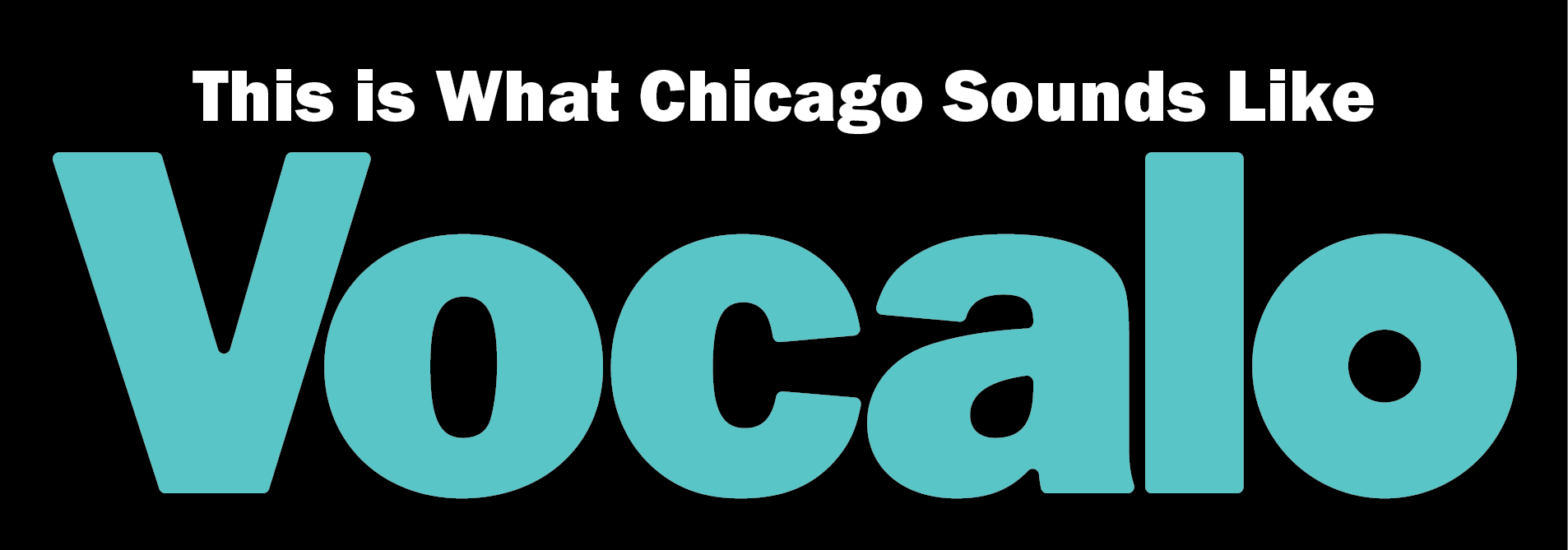Tony Smith Changes the World One Student (and One Photo) at a Time
Written by Vocalo Radio on January 5, 2023
Multimedia artist Tony Smith mentors young artists and teaches them to make a difference with the art they create.
Mississippi-born, Chicago-raised multimedia artist Tony Smith spent his high school days throwing house parties and cutting his teeth in the late ‘70s house music scene. Often collaborating with musical icons like the Chosen Few and Frankie Knuckles, who were his neighbors at the time, he found his footing in the Chicago arts scene — where he would return to follow in his parents footsteps as an arts educator in the latter half of his career.

From high school house parties to college in Atlanta, Smith ultimately ended up in Chicago surrounded by artists including Faheem Majeed, who was then running the South Side Community Art Center. He worked with Majeed curating shows at the Center, finding his way into archival and documentary work of his own — which was later featured by the DuSable Black History Museum.
The Hyde Park Art Center took note of Smith’s work, and offered him the opportunity to walk in the footsteps of his parents in his own way: they asked him to teach their teenage students.
“I’ve spent the last 20 years of my life and the arts, working on ways to expand on our creativity, to share our vibrancy, to help build new artists, to help document older artists that have passed,” explained Smith.
Still teaching at Hyde Park Art Center, Smith cherishes the relationship he builds with his students and how they are able to see things differently. Everything he has learned over the years, he offers to his students. Documenting and creating art that archives Black culture, significant cultural leaders, artists and musicians to young artists, Smith uses his art as a bridge to connect the generations. He teaches his students how to have their own voice through their art and how their voice makes a difference.
“My legacy will be the hundreds of students around the city, in Chicago,that now have been influenced by the greats that I have been exposed to, and can now continue to share their experiences,” Smith expressed.
“Something as simple as a camera or pen can change the world,” he said.
For Tony Smith’s installment of “This is What Chicago Sounds Like,” he speaks on being part of archiving Chicago Black History, working with important Chicago artists and creators, and being inspired by his students.

What do you do?
I’ll say a “multimedia artist,” because I do a mix of photography, video, filmmaking, music production, graphic design, I guess those are all the things that fall into that little scope of multimedia arts.
Are you from Chicago?
I was born in the south, moved from Mississippi to Chicago. As a toddler, my parents were educators here, my father taught at Calumet High School for 30 years, my mother at Phillips High School. Lived in the Chatham neighborhood, then moved out to West Pullman. So went from a completely Black neighborhood to a completely Polish neighborhood. And they both were really interesting and fun.
High School, went to what is now called Gwendolyn Brooks Academy, which was then Mendel. Mendel, everyone knows back in the days, we were the party school. Folks kind of learned and cut their teeth on giving parties. Well, I was giving what is now called house parties. And so I had a chance to work with Frankie Knuckles. And with this organization you guys have heard about called the Chosen Few, they were my neighbors. They were giving parties for me starting in ’78. Going way back.
RELATED: FRANKIE KNUCKLES INTERVIEW ON VOCALO 89.5FM, 2012 (part 1)
So yeah, I’m old, but through that, had a chance to give parties all over the city, and I use that money to pay for college. Because Morehouse then was cheap, so when I went off to college I was going to study medicine. And they asked me a crazy question, all of us, “Who is here to make money, who’s here to save lives?” And I was one of those foolish six that said, “To make money.” [Laughs] They sent me to the business department and I switched from pre-med to marketing.
Finished Morehouse in ’83, went to California, worked for a company out of Chicago called RR Donnelley. And that’s where I kind of got my exposure in graphic design and color reproduction and working with major accounts, and kind of took that knowledge from the West Coast and brought it back here to Chicago. It was one of those things where, when I got here, they said, “You should go visit the South Side Community Art Center.” They said it’s a sanctuary for artists of color.
And when I was there, it was like all of a sudden you have a chance to meet all these incredible people that, again, you have no idea that Kerry James Marshall is going to become Kerry James Marshall, that Amanda Williams is going to become Amanda Williams. Faheem Majeed, he needed someone to help run the center while he was getting his Master’s. I was already working, so I had a chance to work with Faheem and work with the center and curate shows. And it was just a beautiful, wonderful situation. And it’s kept me kind of stabilized in the arts. So I decided I would go to the School of the Art Institute.
My thesis became “Black is Beautiful.” And in that, had an opportunity to interview 40 artists, some that, now, that have passed, but that were living, that could give their stories about the Wall of Respect and the impact it had on the Black Arts Movement and the role that Dr. Margaret Burroughs played. And so that went from just research to a documentary film that we debuted at the DuSable Museum. It turned later into a solo exhibition, and then a coffee table book. And then it expanded from there, where Hyde Park Art Center came and they said, “We kind of like what you’re doing, so would you come teach with us and share this with our teens?”
RELATED: For Faheem Majeed, Chicago Is His Blank Canvas
I’ve spent the last 20 years of my life and the arts, working on ways to expand on our creativity, to share our vibrancy, to help build new artists to help document older artists that have passed. And the most important part, for those of you who don’t know this, is that the more you teach, the more you learn.
I love teaching! And that’s not, it’s not fair — and don’t get this wrong, guys, if you’re listening — I’m not out there trying to take the young knowledge from my teens, but they’re so vibrant, and they see things so differently. And they motivate me, and they give me purpose. I like things when they’ll do crazy stuff, like say, “Mr. Tony, I bought a camera.” “So you serious!” Or, “I’m going to graduate. I’m going to college, and I’m going to study filmmaking.” Those things make you feel good.
I guess I’ve known also as an archivist, because I also document permanent collections, places like the South Side Community, Art Center, etc. DuSable Museum, just capturing the work so we can share it with future generations. That kind of is in a nutshell. I think I said I’m also a musician, throwing that in that bank, and I love playing guitar, and some piano and a little bass.
RELATED: For zakkiyyah najeebah dumas-o’neal, Art is a Vessel for Connection
Wow, you do a LOT! Where did your journey into the arts begin, specifically with which medium?
I started taking pictures when I was 12, 13 years old my father gave me my first camera, it was an SRT Minolta one-on-one. I was intrigued by black and white photography. I had an opportunity to have a darkroom at the South Side Community Art Center. I had one in California, over there as well, but coming to the Center, had a full place to teach, had a darkroom, and really became just entranced with photographing portraits and people. I love body, I love sculpture.
What would you say is your favorite project you’ve worked on?
A project that I worked on that’s probably my favorite now would be my coffee table book. And it’s called “Black is Beautiful.” And it’s 124 pages of a mix of incredible artists, activists, scholars, things I want to dispel, myths, like some youth don’t understand about Black cowboys. And I’m thinking, “Black folk rode horses, and taught other cultures how to ride horses.” But, in this book, I’ve had a chance to document some incredible people and have images that will have a legacy that will last well beyond when I’m on this planet. But, more importantly, I’ve had a chance in shooting them to have their stories.
It was really kind of a take up on [James] Van Der Zee, where people would come by on Sundays in their best dress and would be photographed. In my book, 80% of the people have all been photographed in a small corner in my studio that has the springs and beautiful light. And it’s all about how I use… I guess people say I’m a purist, because I like using things that are very natural. I don’t want… a whole lot of special effects, a lot of retouch. I want clean, beautiful lighting, I want beautiful portraits that show the power and majesty of my people.
How has Chicago shaped you as an artist?
Chicago has shaped me as an artist by being what I would classify as the underdog city. I had friends from New York that came here and made a few mistakes. They was like, “Oh, this art scene is the ‘Chitlin’ Circuit.'” So they left and went back to New York. I had folks here from California and LA, that still felt like, “Well, we wouldn’t have the type of breadth and diversity in a segregated city like Chicago.” But what they forgot was that some of the most incredible people come through this place. We’re in the Midwest, we’re in the center, so you have East Coast, West Coast, Europe coming through, and they stop and they share their gifts… on this city, and they share their gifts. So I feel like this was the best place for me to be, to help build a career.
When you think of your legacy, what do you hope for?
My legacy will be having a chance to act in the role of my parents again. They were educators. My legacy will be the hundreds of students around the city, in Chicago and other places, that now have been influenced by the greats that I have been exposed to, and can now continue to share their experiences, factual experiences. That’s the one thing that I loved about video and photography, is that it’s not someone else’s interpretation. It’s what you see is really happening. With video, it’s the stories that are your story, not his story, but your story, and it can change the world. Something as simple as a camera or pen can change the world.

Since 2016, we have been profiling people who give their all to Chicago and enrich us socially and culturally by virtue of their artistry, social justice work and community-building. Take a listen. Read their words. Become inspired.

Interview and audio production by Ari Mejia
Introduction written by Joshua X. Miller and Morgan Ciocca
Transcription and editing for length and clarity by Morgan Ciocca
Photography by Joshua X. Miller
More from Vocalo:
 Vocalo Radio
Vocalo Radio 











